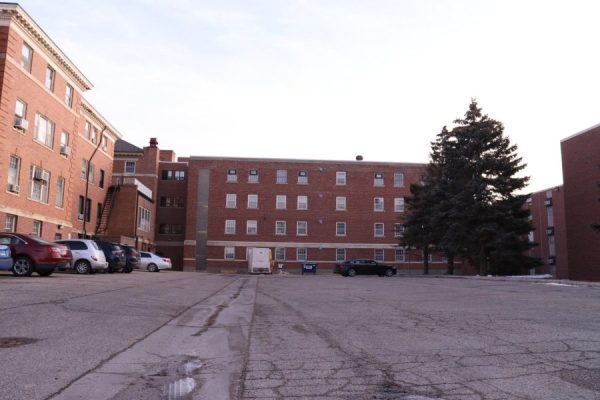Behind the scenes: Doner Auditorium
November 18, 2015
Taking a look at the history, memories, and legacy built by the building
Doner Auditorium was more than just an auditorium to Ray Peterson. It was his second home.
Peterson, who worked in the Theater Department for 40 years, said he remembers building sets on the Doner stage with students many nights; even building sets through the night.
“It was so much more than just a classroom experience for an instructor,” Peterson said. “I made lifetime friendships based on the time outside of the classroom, and Doner Auditorium provided me many hours of working side by side with students I grew to know and love.”
The years he spent in Doner were certainly “good years” Peterson said, but he thinks it is time for a change.
Doner Auditorium has seen a number of changes in its history. It once housed an organ, and the balcony served as more than a storage area at one point. The balcony was used for seating until university officials decided the balcony was not safe because of its limited exit.
The auditorium will see another change once the Theater Department relocates performances to the Performing Arts Center after its expansion is completed. Doner will not remain empty after the shows stop; the auditorium will continue to act as an integral part of SDSU, said Bob Otterson, executive assistant to President Chicoine.
The auditorium will see a complete renovation and a “repurpose” into a large lecture hall once again. The backstage will be repurposed and redesigned to fit the lecture hall design. There are no official plans in the making yet, but using the space as a lecture hall is the main idea right now.
“I just don’t want that space to be gutted and turned into more office space,” Peterson said. “I think it deserves better use than that.”
Peterson doesn’t have to worry about that, according to Otterson. Being an auditorium suggests it was once used as a lecture hall, and the university plans to bring it back to that purpose.
Renovating the auditorium into a lecture hall would fit the need of the university for another lecture facility, and it serves the mission of the university, Otterson said. Doner will continue to be used by the university after more than a century of its construction.
The auditorium was built in 1913. It was not given an official name until it was referred to as the College Auditorium in 1914 and later the University Auditorium, once South Dakota State College became South Dakota State University. Graduation ceremonies, chapel services, lectures and musical performances have been held in the auditorium and it has served as a place of memories for thousands of SDSU alumni and students.
Doner still remains a home for current students like it was for Peterson. Aarron Schuelke, a second-year student in the graduate communications and theatre program, said some his most memorable college experiences were in Doner Auditorium.
“It was my second home for the next four years,” Schuelke said of his undergraduate years at SDSU. “I spent more time in Doner than at my apartments or any of the places I’ve lived.”
In 1963, the Division II men’s basketball national championship game was broadcast in the University Auditorium. Students and faculty gathered in the seats and listened to the game, cheering on the Jacks until the final buzzer, when the Jacks made a last-second shot to beat Wittenberg University 44-42. The event was “quite exciting” said Chuck Cecil, a faculty member at the time.
Those memories extend beyond just a few people who were touched over the auditorium’s century-long existence. Even the auditorium’s namesake since its name change in 1978 cherished the memories he had while in the auditorium.
Former President of SDSU Sherwood Berg honored David B. Doner by renaming the auditorium for him in 1978 “in recognition of [his] long and very devoted service to South Dakota State University and South Dakota.” Doner’s service to SDSU spanned 45 years from the time he attended school to his retirement.
· He first came to State in 1913 as a member of the School of Agriculture’s first four-year class after his eighth grade graduation.
· He enrolled in the college in 1917, but worked on his family farm during World War I until 1919 when he returned to teach in the School of Agriculture.
· Doner became an assistant secretary to the college in 1920 and was appointed registrar in 1922. His title was changed to director of admissions and records in 1953.
Doner attended summer school and classes throughout the year at the beginning of his career. He graduated with a bachelor’s degree in general science in 1928.
His service to SDSU created a lasting impression on the university. As registrar, he signed more than 12,500 diplomas and was the sixth person to be named a Distinguished Alumnus of SDSU in 1964. He was awarded an honorary doctor of humanities degree in 1973.
Doner was able to see his lasting impact take place at State a month before his death in 1978.
The auditorium has been used as a performance venue since its construction, and students in the Theater Department have made their marks on the auditorium, literally, by writing on the walls.
Peterson can’t pinpoint exactly when students began to write messages on the backstage walls at Doner, but the custom was already a tradition by the time he arrived in 1971.
The walls were painted over sometime during his career and a number of students were upset about it. No one was aware the university decided to paint the walls, Peterson said.
Now, the oldest signature Schuelke has identified is from 1987.
When the auditorium in repurposed, an architecture and engineering firm in charge of the project will determine whether or not the walls will be painted over again, Otterson said.
Schuelke himself wrote on the wall before he graduated. He chose the back corner of the dressing room, where he got ready for every show. Schuelke said: “It’s a surreal moment because you’re finding your own place in history that fits all of your college career.”
























